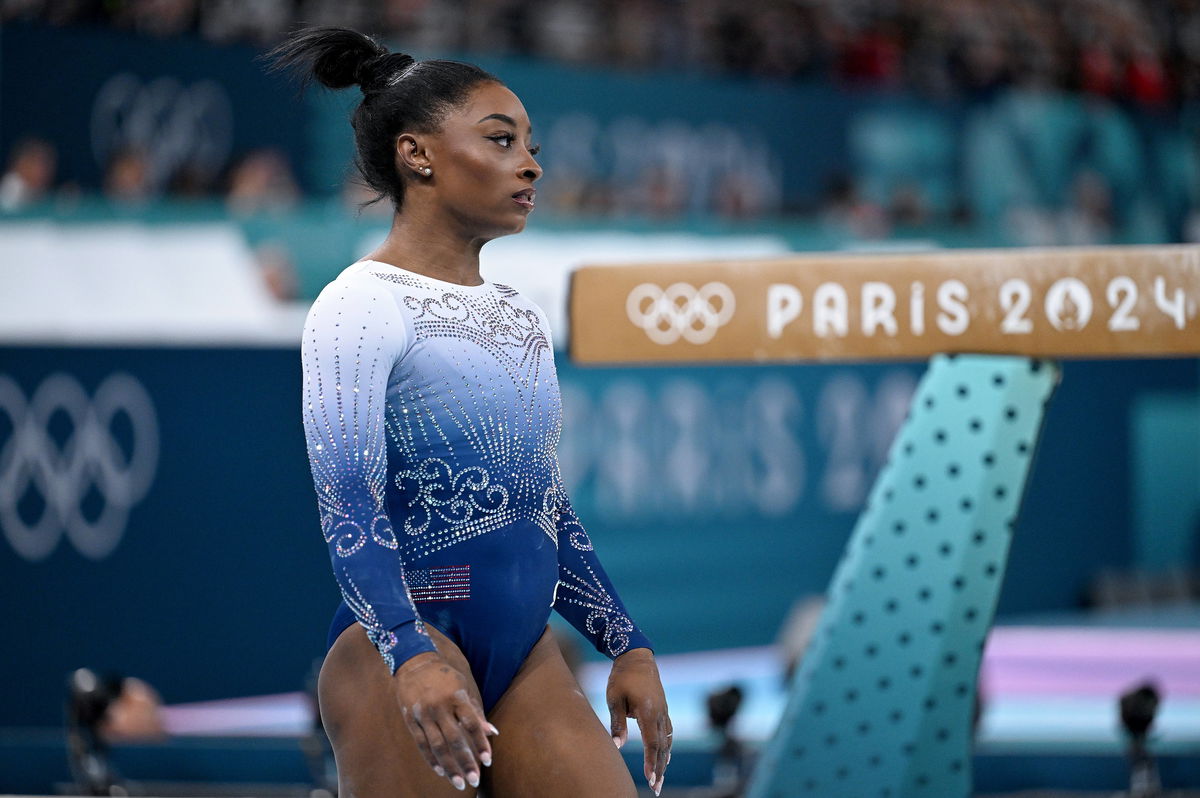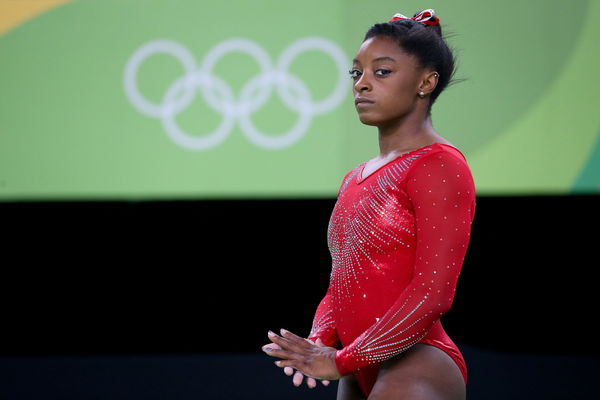
Imago
Paris 2024 Olympics: Womens Balance Beam Final Team USA gymnast Simone Biles reacts during the Womens Gymnastics Balance Beam final competition at the 2024 Paris Summer Olympics, at the Bercy Arena in Paris, France, August 5, 2024. Paris France FRA NOxUSExINxGERMANY PUBLICATIONxINxALGxARGxAUTxBRNxBRAxCANxCHIxCHNxCOLxECUxEGYxGRExINDxIRIxIRQxISRxJORxKUWxLIBxLBAxMLTxMEXxMARxOMAxPERxQATxKSAxSUIxSYRxTUNxTURxUAExUKxVENxYEMxONLY Copyright: xAnthonyxBeharx Editorial use only

Imago
Paris 2024 Olympics: Womens Balance Beam Final Team USA gymnast Simone Biles reacts during the Womens Gymnastics Balance Beam final competition at the 2024 Paris Summer Olympics, at the Bercy Arena in Paris, France, August 5, 2024. Paris France FRA NOxUSExINxGERMANY PUBLICATIONxINxALGxARGxAUTxBRNxBRAxCANxCHIxCHNxCOLxECUxEGYxGRExINDxIRIxIRQxISRxJORxKUWxLIBxLBAxMLTxMEXxMARxOMAxPERxQATxKSAxSUIxSYRxTUNxTURxUAExUKxVENxYEMxONLY Copyright: xAnthonyxBeharx Editorial use only
For the millions who now see Simone Biles as untouchable, there was a time she quietly stood at the edge of the stage, clutching disappointment and trying to smile through the sting of rejection. Long before she was a household name, Biles found herself staring at a scoreboard that didn’t include her name. By one place, by one point—just enough to break her heart, and just enough to light a fire that never went out. One step at a time, that fire carried her all the way to greatness, and the world watched Simone Biles rise into the GOAT she is today.
Watch What’s Trending Now!
In her autobiography Courage to Soar: A Body In Motion, A Life in Balance, Biles opens a window into the earliest chapter of her elite career, a moment neither glorious nor gilded. That debut season as a junior elite gymnast delivered its share of medals and small victories, but they were tempered by insecurity and self-doubt. Among peers she admired, Lexie Priessman, Katelyn Ohashi, and Madison Desch, Biles didn’t just question her routines. She questioned her place. “More than anything, I wanted these girls to see me as one of them,” she admitted.
That summer, she reached the Visa National Championships with a respectable résumé but carried unease. It came to a head when national team coordinator Martha Karolyi requested that she attempt the Amanar, a highly difficult vault Biles had never performed in competition. “Aimee, I’m not ready!” she told her coach. “I haven’t practiced the two-and-a-half enough. It’s not safe.” Her coach, Aimee Boorman, left the choice in Simone’s hands. She chose the safer route, executed a more familiar vault. And finished seventh.
ADVERTISEMENT
Article continues below this ad
And as it happens, Simone Biles did not make the junior national team. As names flashed across the scoreboard, Ohashi, Ross, Finnegan, Priessman, she waited, hoping. Her name appeared one line below the final cutoff. “I had to swallow my own disappointment,” she recalled. “As devastated as I felt, I was still happy for the other girls.” Though she applauded their success, inside she was unraveling. “Tears were bubbling up inside me, but I refused to let the other girls or the coaches see me cry.” The 2011 Nationals could have remained a wound.

Getty
RIO DE JANEIRO, BRAZIL – AUGUST 14: Simone Biles of the United States looks on prior to the Women’s Vault Final on Day 9 of the Rio 2016 Olympic Games at the Rio Olympic Arena on August 14, 2016 in Rio de Janeiro, Brazil. (Photo by Alex Livesey/Getty Images)
Instead, it became a hinge. “That’s how my journey as an elite gymnast began. With a defeat that put an ache in my heart and doubts in my mind,” penned Biles. The setback did not dissuade her. It sharpened her resolve. Within four years, she would become world champion. By 2016, she was the face of the Rio Olympics. And in her own words: “I thought my failure at the 2011 Nationals was an ending, but it was really a beginning.” The journey from near anonymity to global acclaim is often described with broad strokes.
ADVERTISEMENT
Article continues below this ad
Biles, however, gives readers something far more honest. A portrait of a girl with talent but no guarantees. Her greatness was not stitched together in one summer. It grew from a moment she would rather have forgotten, one that nearly convinced her she didn’t belong. But she turned the page. And that decision, more than any gold medal, explains why she stands alone.
How Simone Biles became the ultimate standard in gymnastics
It was in Rio de Janeiro, under the stiff gaze of a global audience, that Simone Biles constructed the foundations of a career that would, in time, come to redefine her sport. At just nineteen, her performances did not merely meet expectations—they surpassed the very boundaries of what women’s gymnastics had previously entertained as possible. With four gold medals and a bronze, Biles distinguished herself not only by the difficulty of her routines but by the precision and control with which she delivered them. Few athletes have so convincingly reoriented the scale of excellence within their discipline at such an early stage.
ADVERTISEMENT
Article continues below this ad

Reuters
Paris 2024 Olympics – Artistic Gymnastics – Women’s All-Around Victory Ceremony – Bercy Arena, Paris, France – August 01, 2024. Gold medallist Simone Biles of the United States celebrates on the podium. REUTERS/Hannah McKay
Five years later in Tokyo, she returned to the Olympic stage in an entirely different light—no longer the prodigy, but the centerpiece. She arrived as the presumed favorite, only to face a silent, deeply personal crisis known in gymnastics as the “twisties,” which forced her to withdraw from most events. The withdrawal invited public scrutiny, but Biles stood firm. “I just felt like it would be a little better to take a back seat and work on my mindfulness,” she stated plainly. Despite stepping away from competition, she secured a bronze on balance beam, a result more symbolic than statistical. Her reappearance in Paris, however, reestablished her authority. She won gold in both team and individual all-around, a final assertion of her capacity to return to the summit on her own terms.
Since then, Biles has allowed herself the latitude of a quieter life. Her travels with her husband Jonathan Owens, including several restful interludes overseas, suggest a contentment not previously seen during her earlier competitive years. Though her discipline remains unmistakable, she no longer carries the full weight of expectation. Her work is done, and the consensus is firm: Simone Biles has become what gymnastics had never quite seen before. In chasing perfection, Simone Biles uncovered something rarer. This was clarity, resilience, and a legacy that no score could ever define!
ADVERTISEMENT
ADVERTISEMENT
ADVERTISEMENT
ADVERTISEMENT

